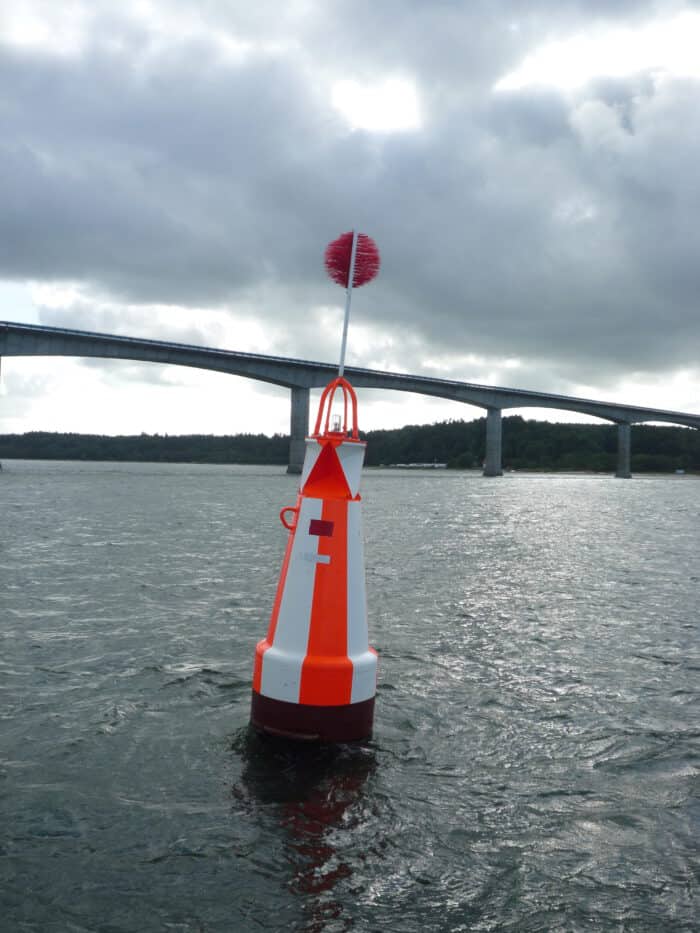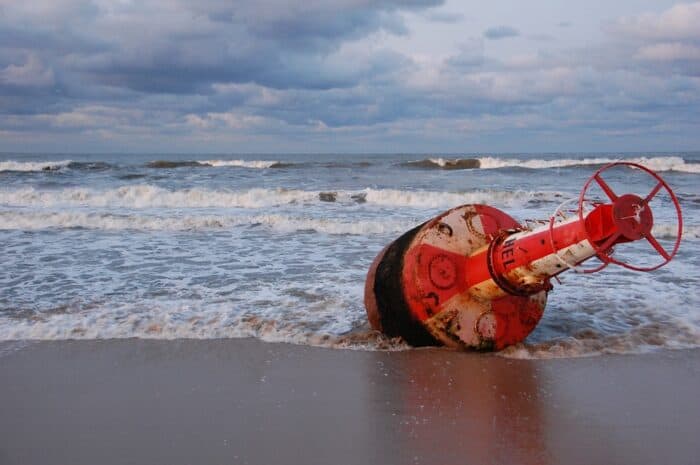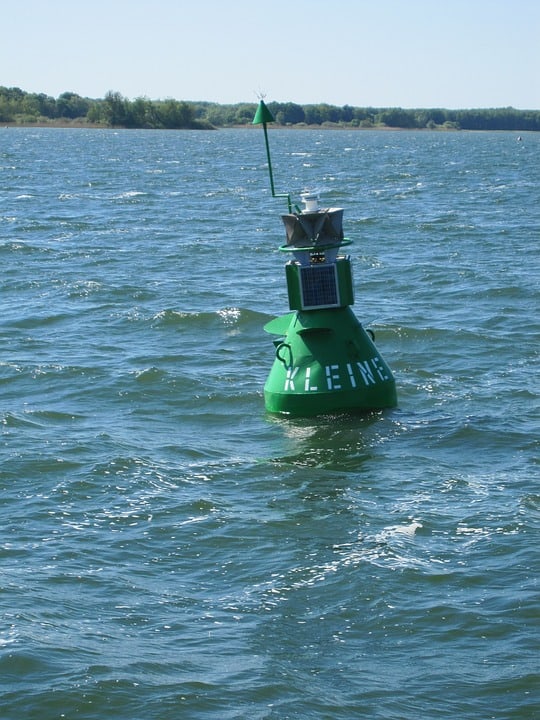What Color Are Safe Water Markers?
Safe water markers are buoys marked by white body and red stripes or an even distribution of red and white stripes. They can potentially come in a variety of shapes including spherical and can shaped as well as cone shaped, though they are often larger and of the more common buoy-shape that we’re used to when it comes to navigational buoys. They can have vertical red and white stripes all around or they may be half red and half white with a ball on top. The ball on top of a safe water buoy will be red.
Are There Light Signals on a Safe Water Marker?

Some safe water markers will have light signals. This, unfortunately, can be confusing for some newer or unfamiliar boaters because there are a number of potential signals that the buoy may use. In fact, a safe water buoy may demonstrate four entirely different light signals.
- Morse Code Signal: Some safe water buoys will flash the Morse Code for the letter A. That is abbreviated as “di-dah” very often or simply a dot followed by a dash. In practical terms, a quick flash followed by a longer flash.
- Occulting Signal. This is a term most people aren’t familiar with and is often explained as a signal that is more light than dark. What that means in real terms is that, when you see this signal, the light will be on for a period of time, then off for a shorter period, then on again. So a sustained burst of light, a short period of darkness, and then repeat.
- 10-Second Signal: This is called an isophase signal and it just means that the period of light and dark is equal, so you’ll see ten seconds of light, ten seconds of dark, and then repeat.
- Long Flashing: Similar to the 10 second signal, this would just be one long flash every 10 seconds but not necessarily followed by an equal amount of darkness.
All light signals on safe water markers are going to be white, not any sort of colored light. In addition, not every safe water marker will even have alight signal equipped so you may or may not see these as you approach a safe water marker.
Are Safe Water Markers Channel Markers?

The purpose of a safe water marker buoy, which is also sometimes called a fairway buoy or a mid channel buoy, is to indicate the center of a navigable channel. So yes, a safe water marker is a kind of channel marker, though there are definitely other kinds of channel markers as well.
One thing to remember about a safe water marker that differs from many other kinds of markers is that it is not cautioning you against anything. There are a number of lateral markers that are designed to indicate where you should go and where you shouldn’t go.
For instance, inland waters obstruction markers will be white and black vertical stripes. If you see two of these they indicate that you should not pass between them because there is some kind of obstruction to navigation present and it could either impede progress or damage your boat. An obstruction marker is therefore closer to the opposite of navigational aids like a safe water marker.
The difference with a safe water marker is that it’s letting you know the water is safe on all sides. For that reason, either side of the channel can be navigated safely and without worry. That said, even though all water around the water is considered safe, whenever it’s possible it is recommended that you pass one of these buoys on the port side. That makes it easier and safe for all boats in the area to navigate around each other when there is no confusion about which direction another vessel may be coming from.
Where Do You Find Safe Water Markers?

You can actually find a safe water marker just about anywhere. That said, you’re most likely to find them specifically where you begin your navigation in and out of a harbor, in the middle of channels and other fairways that you should be using to navigate in and out of the area.
The safe water marker is generally going to be located at the end of a channel if you are on your way out to sea or the beginning if you are on your way into harbor. When you see one there may be no further buoys beyond and that means the buoy is letting you know you have just reached safe, open and deep enough waters that you are able to safely travel.
Depending on the location, this meaning can change, of course. For instance, if you are in shallow water, safe water buoys may exist along a path to indicate the safest way to travel through those waters, sort of like guide posts to show you the best way through.
Additionally, a safe water buoy could be used to mark the beginning and the end of a narrow channel that has additional buoys along it which you will need to pay attention to in order to safely navigate from one side to the other. As always, you need to be fully aware of all channel buoys, lateral buoys, hazard marker buoys and so on to get the full context and understanding of where it’s safe to travel in certain waters.
Are The Red Vertical Stripes Markers Related to the Green Markers?

This can get somewhat confusing in terms of your lateral markers, but they are not the same kind of buoy. The red and green markers you see are also channel markers but of a different kind.
The red markers do indicate where you should be navigating, much like the red on a safe water marker, but the context is different. Remember, a safe water marker tells you that all water around the marker is safe and navigable and is both red and white. This is not what the red and green lateral markers are telling you.
Red and green markers indicate the channel you should travel which is typically between those markers. A red marker may also be called a port marker. As we saw above, you should be passing a safe water marker to port as well, so there is that aspect in common. Red to port is something common to a lot of aspects of boating. But you also need to be conscious of if you’re travelling upstream or downstream.
Downstream means you are travelling away from land and out to sea. Upstream indicates you are travelling from sea back into port or harbor.
When you’re heading upstream or into harbor, follow the rule “red right returning.” That means you’ll keep the red marker to the right or starboard side of your vessel. A major difference between these and safe water markers is that you could, in some circumstances, pass a safe water marker to starboard or port. We know this because it is safe on both sides of a safe water marker and that is the key difference here.
You would not want to pass a red lateral marker to your starboard side rather than port on the way downstream or out to sea. That could be dangerous for you and your boat as well as other boaters on the water. On the way out of the harbor you will keep the marker to the other side of your boat.
The green lateral marker, the starboard marker, is the one you should be keeping to the starboard of your vessel when travelling upstream or out to sea. You need to be conscious of whether you are heading into harbor or out of harbor to determine where these markers should be relative to your boat. However, a safe water marker will always be safe in any context so it’s not always an issue.
Are White Markers with a Blue Horizontal Band Safe Markers?

You will see vessels approaching markers that are white with blue stripes as well, but these too are different from safe water markers. A white buoy with a blue horizontal band around it is actually a mooring buoy and these are the only buoys that it is safe and legal to attach your boat to.
Because you can approach a mooring buoy it does indicate that the water around it is safe to navigate in a limited context. However, unlike the other channel markers and, in specific, safe water markers, it is not intended to mark waters that are safe to navigate. The sole purpose is to indicate a safe place to moor your vessel.
Mooring buoys are typically much heavier than normal buoys because of what they are used for. That said, it’s generally safe to pass on either side of an unused mooring buoy as you would pass by a safe water marker as well. However, you need to be aware of the other buoys in the area and what they may indicate for safe passage through the channel since a mooring buoy on its own does not offer context for how to navigate the area.
The Bottom Line
Safe water markers are channel marker buoys that indicate safe, navigable waters on either side. They may come in several different shapes and sizes, with or without lights, but are always marked with red and white vertical stripes.
It is safe to pass on either side of a safe water marker but generally passing to port is the preferred and standard option. Other markers like red and green lateral markers and mooring buoys can indicate safe water in specific circumstances, but not in the same way that a safe water marker does.
Categories: Boats











